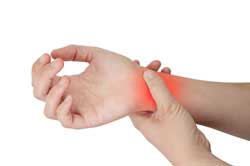Wrist Fracture Treatment in Johnson City, TN

With eight small bones and the two forearm bones all meeting within your wrist, it should be no surprise that wrist fractures are the most common fractures in people under the age of 65.
Wrist fractures generally happen as the result of some form of trauma. They could be related to playing sports, being involved in an automobile accident, or simply trying to catch yourself when you fall. If you believe you have broken your wrist, it is important to contact us immediately. Please call (423) 482-8711 or contact Dr. Dalal Akoury online.
Bones Involved in a Wrist Fracture
The most common place where a wrist fracture occurs is at the end of the radius. The radius is one of the two bones that make up your forearm. The second bone in the forearm is the ulnar. The end of this bone can also be injured, but this generally happens less often.
There are eight small bones in the wrist that are responsible for the delicate movements we are capable of making with our wrists and hands. One of these bones is known as the scaphoid, and it can also be involved in a wrist fracture.
How to Tell if You Have a Wrist Fracture
There are a number of wrist fracture symptoms. If you are experiencing any of the following symptoms please call (423) 482-8711:
- Severe pain
- Bruising
- Swelling
- Numbness
- Visible deformity
- Inability to move the fingers or thumb
Diagnosing and Treating a Wrist Fracture
The quickest way for your doctor to confirm that you have a wrist fracture is to perform an imaging test such as an x-ray, CT scan, or MRI. If it has been determined that a fracture occurred, the first step is to realign the injured bones. This process is called resetting the fracture or fracture reduction, and it may be performed with the use of a local anesthetic.
Once the bones have been reset, the next step is to protect the wrist and give it time to heal. This can be done with either a splint or cast. Your doctor may prescribe medication to reduce pain or swelling. Physical therapy may also be recommended to help restore range of motion after the bones have healed.
In severe cases, surgery and the use of plates, screws or other supportive devices may be the only option for resetting the damaged bones. Some of these instances include:
- Severely misaligned bones
- Multiple breaks in the wrist
- Loose bone fragments
- Ligament damage
- Fractures that affect the cartilage in the joint
Get Help Right Away
A wrist fracture needs to be treated immediately to ensure that the bones are properly aligned and heal correctly. A wrist that is not taken care of after a fracture can lead to a lifetime of arthritis pain and stiffness in the hands and fingers. If you believe your wrist is fractured, please call (423) 482-8711 or contact Dr. Dalal Akoury online.
AWAREmed Health and Wellness Resource Center
Address
1604 Lamons LaneSuite 202
Johnson City, TN 37604
(423) 482-8711
www.awaremed.com
Hours
Mon:
9:00 am - 5:00 pm
Tue:
9:00 am - 5:00 pm
Wed:
9:00 am - 5:00 pm
Thu:
9:00 am - 5:00 pm
Fri:
9:00 am - 5:00 pm


